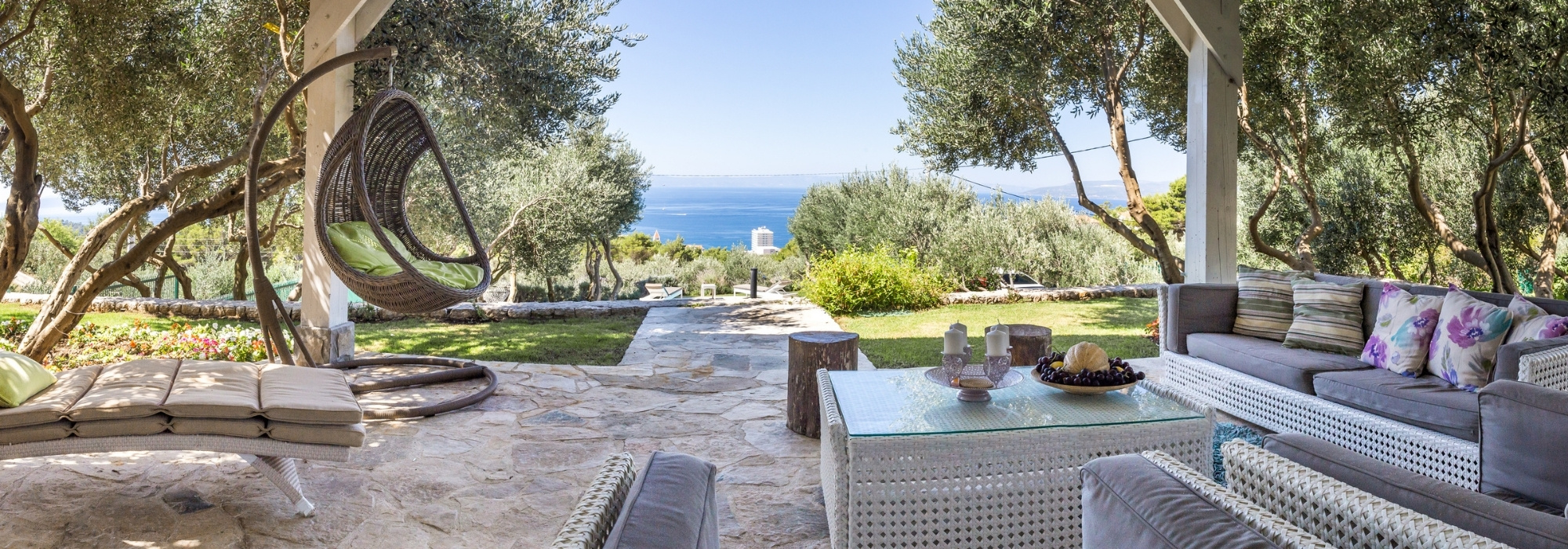
Designing a garden where it never freezes
Tips and atmospheres for mild climate
Contents
Our hexagon is a small country on a global scale, but it boasts a great wealth of landscapes and climates. The mild climate zones – primarily located around the Mediterranean – allow gardeners to unleash their desires and creativity without worrying about the hardiness of the plants they choose. Creating a garden where it never freezes is exhilarating and reserved for privileged gardeners fortunate enough to reside in very mild latitudes. So if you are one of those lucky ones, make the most of it! From considering the constraints of your land to choosing the style of garden and associated plants, we explain how to successfully plant and create a garden where it never freezes.
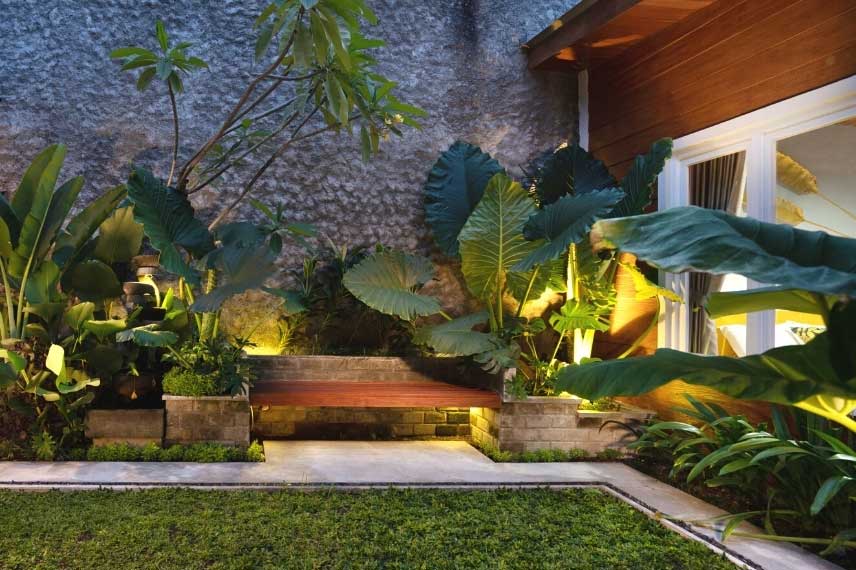
A privileged atmosphere, sheltered from winter frost
Mild climate zones in France
France is divided into 8 climatic zones, which correspond to the USDA climate zones from the United States Department of Agriculture, defining hardiness thresholds for each zone. The south of France includes:
- Type 7 climate, known as “South-West Basin Climate”, corresponding to USDA zone 9b (from -3.9 to -1.1°C). Here, the average annual temperature exceeds 13°C, and there are more than 23 warm days. Precipitation of less than 800 millimetres is more frequent in winter (9-11 days) than in summer (fewer than 6 days). The variability of precipitation from year to year is average.
- Type 8 climate, known as “True Mediterranean Climate”, corresponding to USDA zones 10a (from -1.1 to 1.7°C) and 10b (from 1.7 to 4.4°C). Here, cold days are extremely rare, and warm days are frequent. The temperature range exceeds 17°C between July and January. Precipitation is much more abundant in autumn than in summer, and these summers are arid.
What is known as the “orange zone“, reputed to be the most temperate, extends along the coastal strip from Menton to the west of Toulon and also includes the tip of the Pyrénées-Orientales. In Corsica, it stretches along the coasts. To create a garden that does not experience frost, one must therefore be situated in this area and consider complementary factors such as the prevailing winds, namely the Mistral and the Tramontane, which can challenge gardeners but also jeopardise plants! It is also essential to take into account the intrinsic constraints of your garden to ensure that its layout is a success that delights you for years to come.
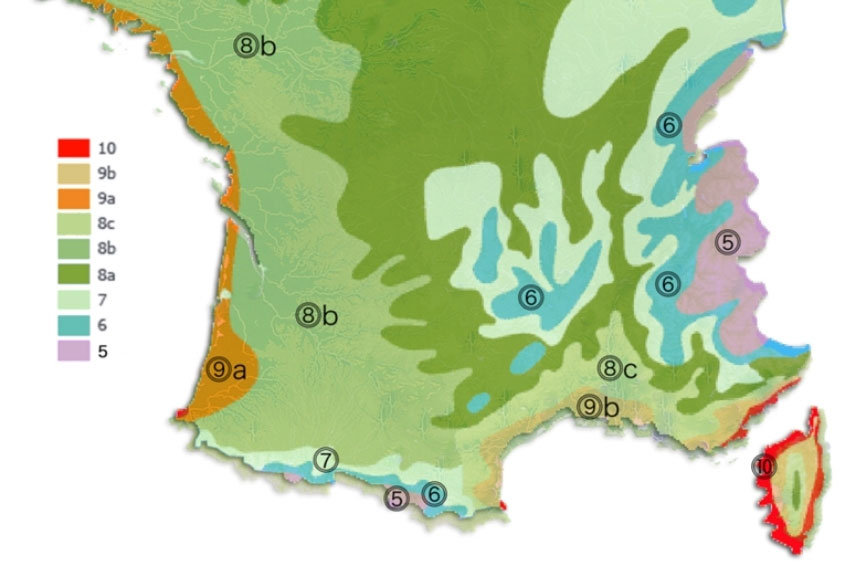
Map of USDA hardiness zones
Read also
How to design a tropical garden?Consider the constraints of your plot.
Depending on the constraints of your space, the landscaping solutions will differ. Designing a small enclosed space and a large terraced area swept by the Mistral is not the same. You will need to consider the following elements:
- The size of the garden, which may or may not allow for the planting of large specimens, and may require phasing the landscaping work. Take measurements and sketch a plan, even a rough one: this will help you visualise things better.
- The type of soil, which will require adapting the plant palette and planting methods. If the soil is clayey and compact, plants suited to mild climates will need drainage to withstand winters. The pH should also be taken into account.
- The initial state of the garden: what existing plants are there? Which ones to keep or remove, those that are diseased or unsuitable due to their size. What elements will enhance your landscaping project: a pergola against the house wall, large stones scattered throughout the garden, a pond or a fountain.
- Elements that promote a micro-climate ideal for your project: orientation, the presence of hedges and windbreak trees. Is your garden by the sea and would it require choosing plants that can withstand salt spray?
- The available water resource: if you have a borehole or a well, it will be easier to plant tropical-looking plants. Conversely, if you want to conserve this precious resource, you will need to adapt your choice of plants and likely lean towards the most undemanding species.
Once these constraints are listed and the basic plan of your garden is sketched out, you need to define the style of the garden and the associated plant palette: don’t go in all directions and keep in mind the essence you want to give to your garden, in harmony with your lifestyle and the architecture of your home.
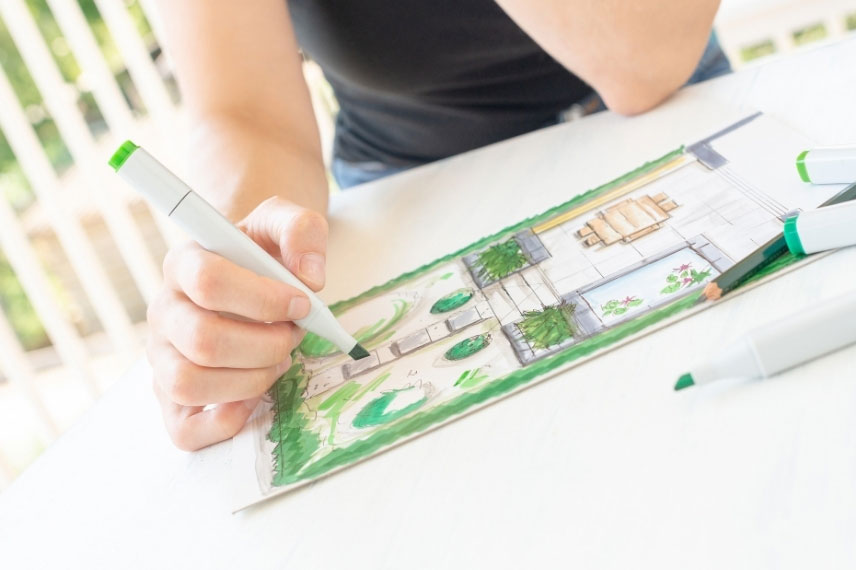 Creating a sketch or plan of your garden helps you think more clearly about its organisation
Creating a sketch or plan of your garden helps you think more clearly about its organisation
Draw inspiration from the Riviera gardens, where classicism meets exuberance.
The gardens of the Côte d’Azur, which flourished in the 19th century, have invited a mixed vegetation perfectly adapted to the soil and ambient environment. Gardens of travel, escape, scents, and good cheer, they are generous all year round. Essential plants can be found in these gardens of the “French California”:
- the palms, such as the Washingtonia robusta, tall and appreciated for its magnificent silhouette, rapid growth, and undemanding nature. It tolerates salt spray well and withstands summer drought perfectly. Elite subjects of the gardens, palms bring an undeniable touch of exoticism and luxury to planted spaces.
- The trees with precious flowering such as Mimosa, Albizia, Bottlebrushes (Callistemon), and Crape myrtle (Lagerstroemia). And of course, the essential olive trees.
- The shrubs such as the oleander: ultra-floriferous, with single or double flowers in pure white, light yellow, salmon, light pink, or red, it is prolific and very easy to grow.
- The climbing plants such as bougainvilleas, blue Plumbago, and jasmines
- The orange tree and the four seasons lemon tree
- The Lantana, which adorns itself with flowers all summer long
- The Strelitzia reginae or Bird of Paradise
- the precious perennials such as agapanthus in blue or white and spectacular like the Echium fastuosum or Madeira viper’s bugloss.

Iconic plants of the Côte d’Azur: plumbago, oleander, mimosa, palm Washingtonia, Bird of Paradise, Orange tree, and bougainvillea
Read also
How to create a dry exotic garden?Dare to escape by drawing inspiration from the gardens of the Alhambra.
Heirs of the refined Hispano-Moorish culture, the gardens of the Alhambra in Granada are built on successive terraces and patios. They are characterised by the complete mastery of water, which feeds the basins and irrigates the crops. These gardens take the form of orchard gardens divided by paths and channels, shaded by pergolas covered with climbing plants (roses, jasmines, honeysuckles, and bougainvilleas) that also climb the walls, and are punctuated by fruit trees (pomegranates, citron trees, or fig trees). The straight basins are surrounded by trimmed hedges of boxwood and myrtle, and animated by roses and polygala in bloom. An ideal model of a southern garden in full sun, from which you can draw inspiration to style a walled garden or sunny courtyard, complementing the decor with warm ochre and cream colours on the walls, and choosing pots that match this style. The ideal? Plan for the installation of a fountain or water feature that will refresh the atmosphere and beautifully complete the decor!

Plant atmosphere of the Alhambra: jasmine, rose, citron tree, crape myrtle, and pomegranate
Embrace exoticism with an exuberance of colours and unique foliage.
A lush, green, and generous garden, the exotic garden is a dream come true and transports you to a postcard scene! However, beware of cold snaps from strong winds or lack of watering, which could turn the postcard into a still life, with plants wilting on their stems. For such an atmosphere, you can combine:
- the remarkable Elephant Ear Alocasia macrorrhiza with its rapid growth
- the Farfugium japonicum
- the hybrid Protea ‘Clark’s Red’
- the Japanese Fan Palm Livistona chinensis
- the Rice Paper Plant Tetrapanax papyrifera ‘Rex’
- banana plants,
- hibiscus
- the tree ferns whose magnificence recalls ancient forests.
- Cycas revoluta
- the cannas with their exotic colourful flowers
Install a drip irrigation system, which will save water while ensuring the splendour of your cultivated jungle.

Top left: tree ferns, Cycas, and Farfugium. On the right: banana plant. Below: cannas
Save water with plants from arid regions
The water resource, which is so important to preserve, is not necessarily available at will for everyone. Rather than seeing it as a constraint, turn it into a strength and create an arid zone garden that is economical in watering and maintenance. Embrace the striking yuccas, agaves, cacti, and succulents:
- the Elephant foot Yucca, Yucca elephantipes ‘Jewel’, with impressive growth
- the dasylirions with tufts of linear leaves
- the agaves, keeping in mind their somewhat invasive nature
- the aloes, including Aloe arborescens with its bright and colourful flowering
- the opuntias, known as prickly pear cacti
- the Beschorneria, with leaves completely free of spines
A key requirement for this type of garden: drainage. Raise your beds and provide drainage using gravel or coarse river sand if your soil is clayey. Animate the beds with stones of different sizes arranged naturally and mulch the soil with gravel.
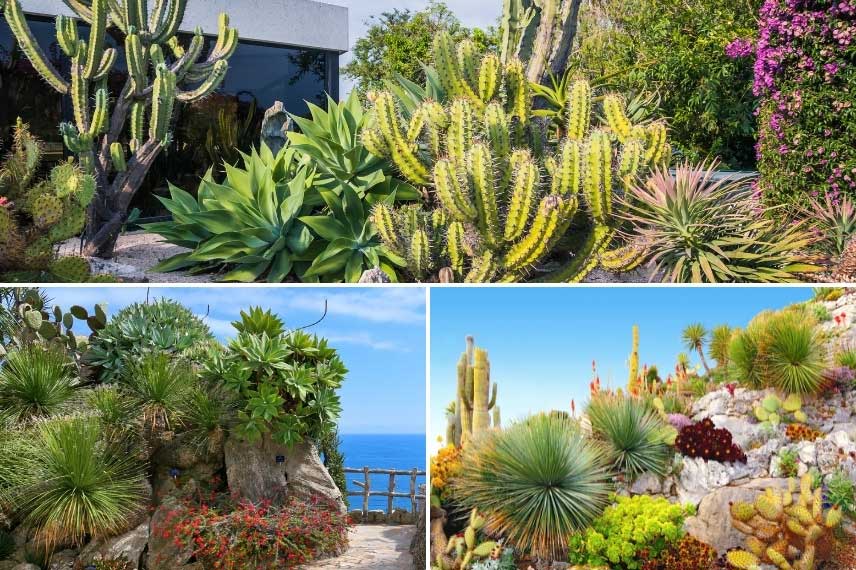 Gardens in mild climates planted with plants from dry and arid zones
Gardens in mild climates planted with plants from dry and arid zones
- Subscribe!
- Contents
































Comments